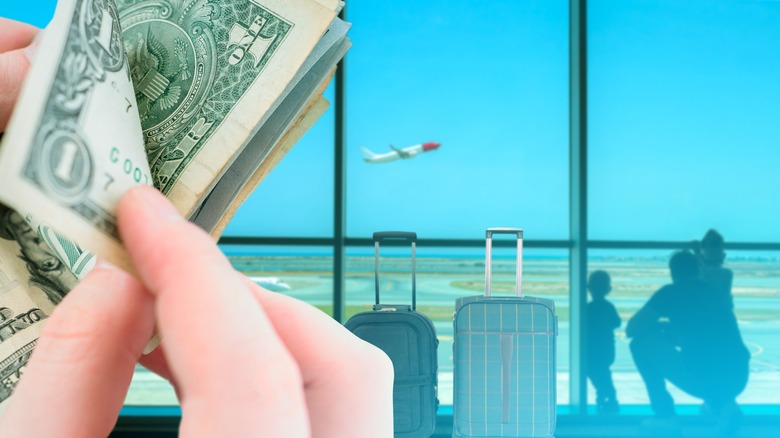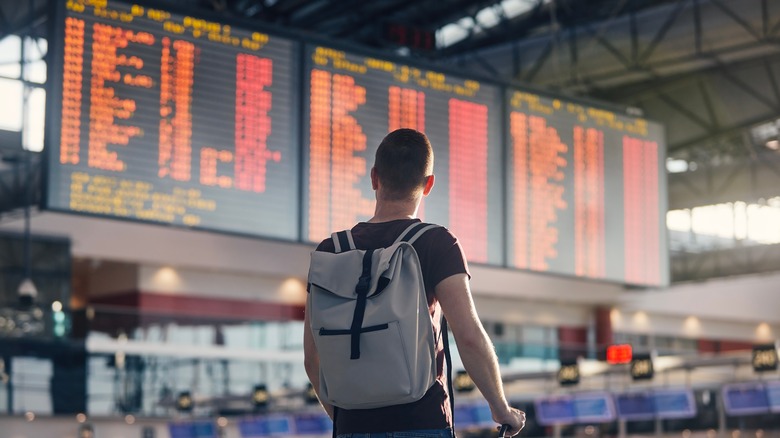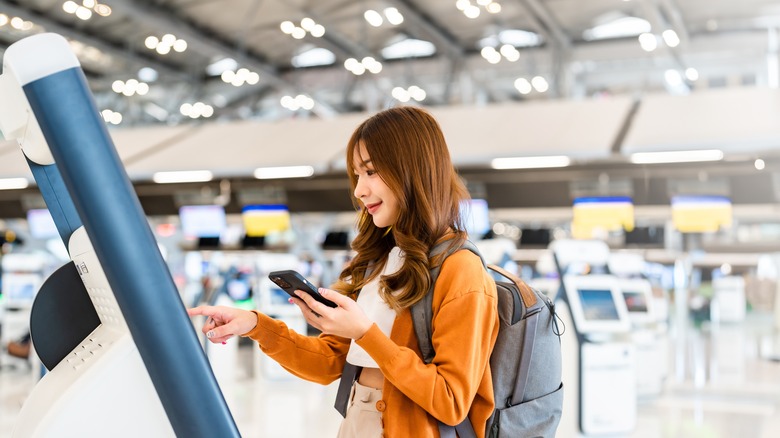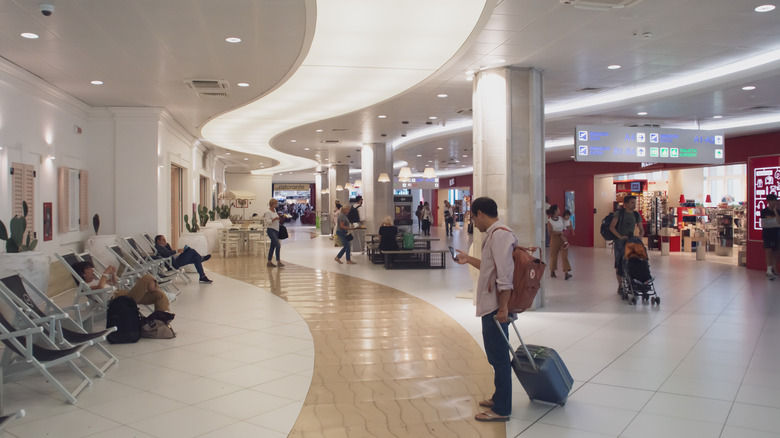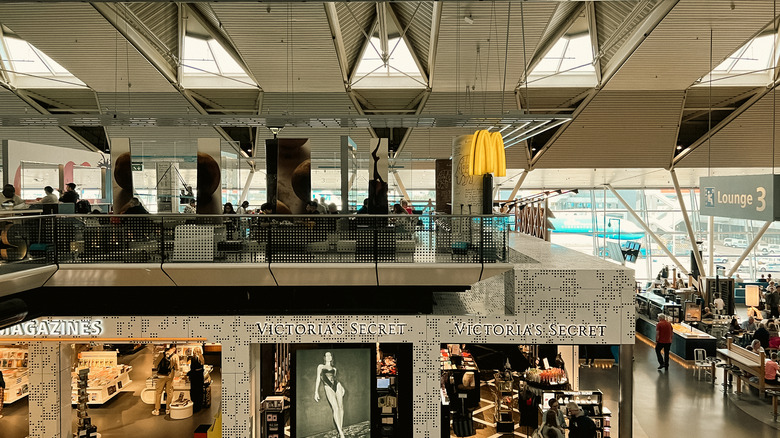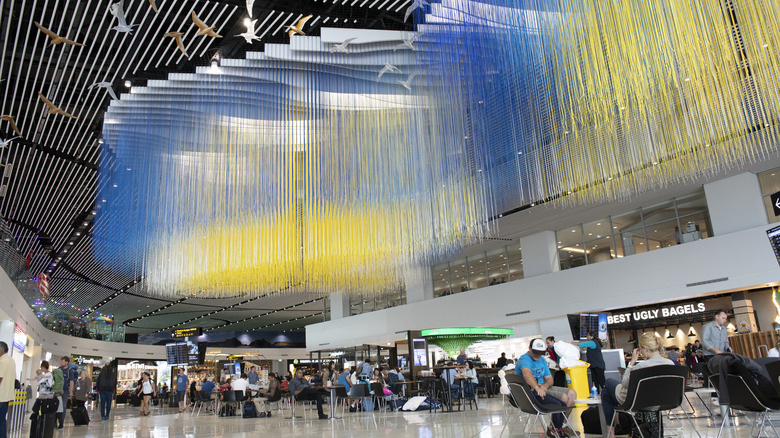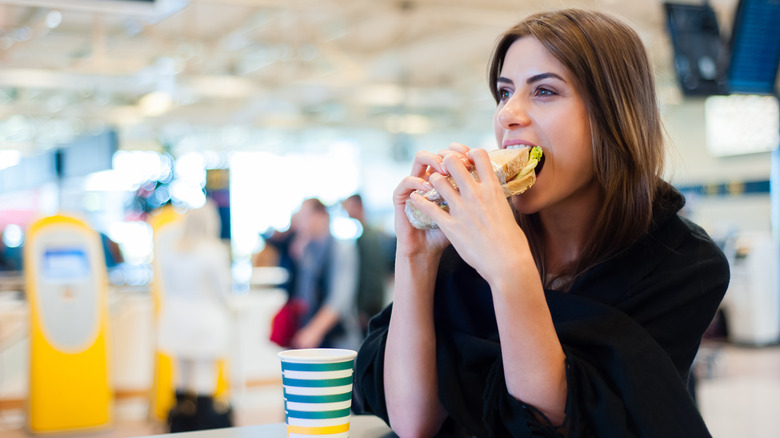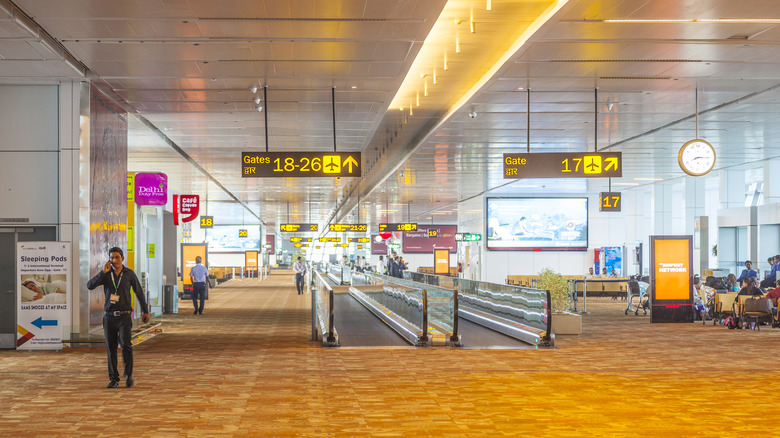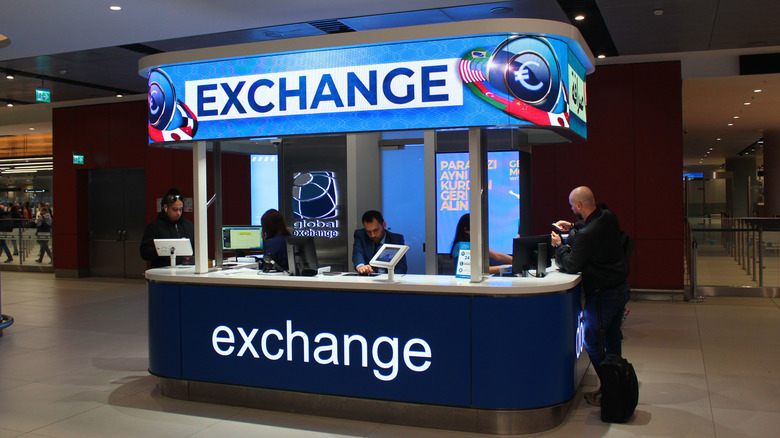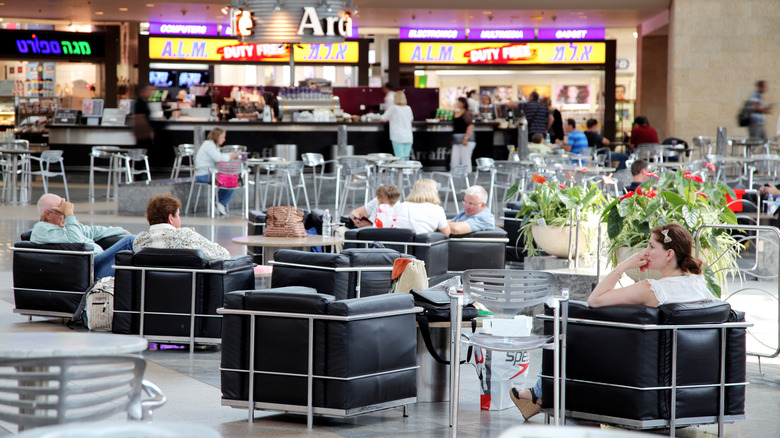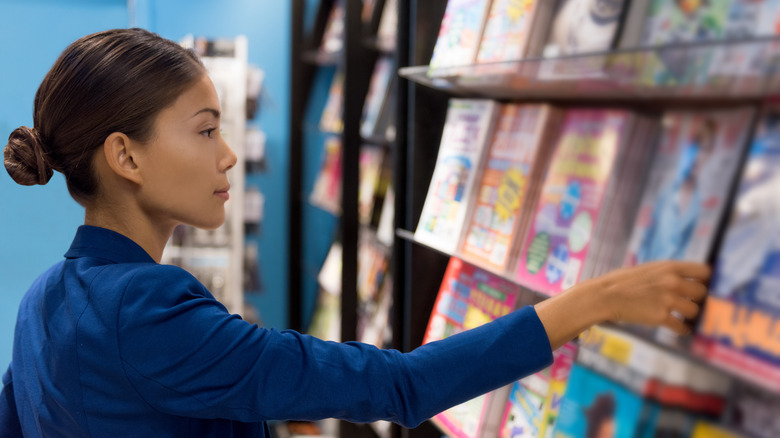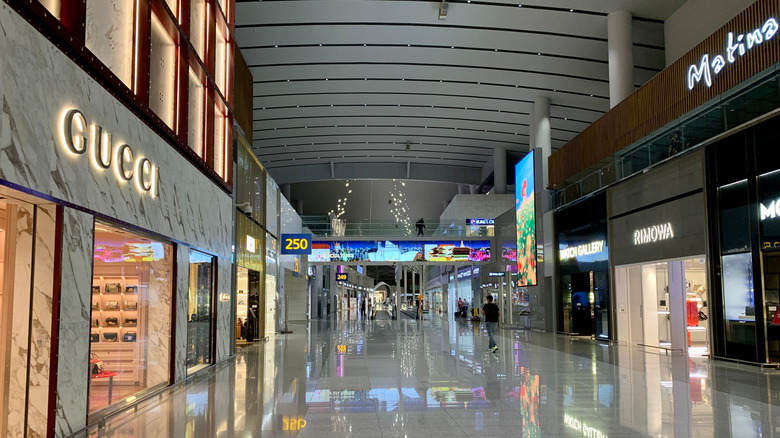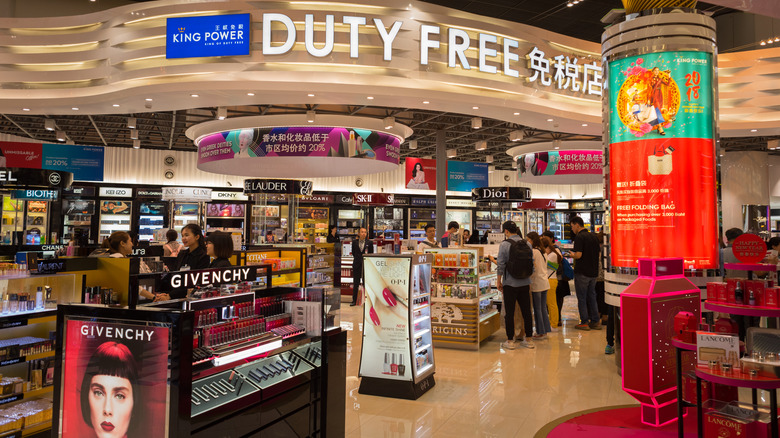The Sneakiest Ways Airports Trick You Into Spending Money
Airports have evolved beyond being just transportation hubs; they have become a complete shopping ecosystem for all kinds of stores and experiences. According to Airports Council International, non-aeronautical revenues like retail and advertising made up 40% of airport earnings before the pandemic in 2019. And so it comes as no surprise that airports spare no effort to turn passengers into consumers, especially during the time window between security and boarding, known as the "golden hour."
From meticulously planned layouts and displays to the allure of duty-free bargains, airports employ a range of tactics to persuade you to open your wallet and contribute to their revenue. They hone the art of persuasion through a combination of psychology, technology, and strategic design, transforming the terminal into a shopping paradise where every corner holds the potential for a profitable transaction.
While some of these efforts may appear as helpful conveniences to enhance your overall experience and relaxation, it's important to acknowledge their effect on enabling and facilitating spending. After all, according to J.D. Power and Associates (via the Journal of Air Transport Management), satisfied passengers will spend more on retail purchases.
Strategically placed duty-free shops
Airport duty-free shops have become a prominent part of the travel experience, an almost obligatory stop with promises of tax-free luxury items and other deals. Our obsession with duty-free shops doesn't happen by chance; airports are carefully designed to influence travelers to go and spend money at these shops.
First, duty-free shops are strategically positioned right after security checks, a process that can be tedious and stressful for some people. After clearing security, travelers begin to regain composure and feel more relaxed, and there the shops are, right in front of them. Even if the urge to shop doesn't arise at this point, travelers have to walk through the shops to reach the departure gates, increasing the chance that something will catch their attention.
Another trick to watch out for is the illusion of savings. The allure of duty-free shops lies in their tax-free prices, leading travelers to believe they're getting a bargain — which is not always the case. Certain heavily taxed goods, like liquor, tobacco products, and luxury items, may be cheaper than in regular retail stores, but prices are similar or even higher for others. Check the standard or online prices and compare them before making a purchase.
Huge boards showing walking time to your gate
Navigating airports can be daunting — everyone is rushing, and there are many things to go through. Fortunately, you can see oversized signage everywhere, announcing everything happening, even displaying the estimated walking time to your gate. Beyond its primary function of guiding you through the expansive airport, these signs also play a role in helping you relax and putting your mind at ease. Upon seeing the board, you will feel less tense and rushed, realizing you know precisely where to go and how much time you have to spare before boarding.
With this information and reassurance, you start feeling a sense of control that allows you to linger, explore, and enjoy some leisure. After all, if you have time to spare, why not treat yourself to a delicious meal or indulge in a spot of retail therapy, especially if you'll soon be cooped up inside an aircraft for hours? The next time you see these signs, appreciate the convenience they offer and remind yourself that just because you have time doesn't mean you need to shop and spend money.
Faster check-ins, longer dwell time
It has long been accepted as standard practice to arrive three hours before an international flight and two hours before if it's a domestic trip. Most travelers and airlines have echoed these recommendations for decades. While this advice holds merit — as you certainly need ample time to comfortably go through the full process and account for unforeseen factors — it's been upheld for reasons beyond simply ensuring you don't miss your flight.
With the availability of online check-in, methods for skipping the lines at the bag-check counter, and programs like TSA PreCheck, the process has certainly become easier and faster than it used to be. Even so, many airports still don't announce your gate number until just before boarding starts, typically 30–50 minutes before the flight. Usually, that leaves you up to an hour or more to roam around the terminal, where the retail stores and restaurants are located. This time between clearing security and boarding makes up part of the period called the golden hour, and airports pull out all the stops to capitalize on this window.
Bending walkways makes you look at more products
Next time you find yourself strolling through an airport, pay attention to the walkways. Do they bend to the left? If the answer is yes, there's a reason for it. This seemingly innocuous design choice is actually a carefully calculated strategy to entice you to spend more money. While walking through the airport terminal, most people will carry a suitcase or luggage in their right hand, leading them to walk counterclockwise for balance instinctively. The bending walkway then aligns harmoniously with this instinct, creating a sense of flow and rhythm that seamlessly guides you through the retail area.
A walkway that bends to the left also allows more space to display merchandise on the right side, which is advantageous because people tend to naturally look to the right more than the left side, according to aviation consulting company InterVISTAS. Bending walkways also make the path longer and prolong the time spent walking within the retail area, presenting passengers with more opportunities to browse and shop, as the InterVISTAS report also unveils.
Natural light and wide aisles invite you in
Beyond airports, the retail industry has capitalized on the psychological impact of natural light to create an inviting and stimulating environment to make more sales. According to infrastructure company Utilities One, studies have linked exposure to natural light with positive mood and satisfaction, which can translate to higher sales figures. In airports, the shopping areas often benefit from expansive glass facades near the tarmac, inviting passengers to walk towards the shops. Once you're near the store, natural light further enhances the visual display of goods and merchandise, making them look more appealing.
The inviting natural light and wide corridors and open areas within airport terminals encourage leisurely strolls, helping you feel more relaxed rather than rushed. The spacious corridors will also make it comfortable to enter stores even while lugging around your bags. This seamless integration of retail spaces within the airport environment makes it a breeze to go in and out of stores, sometimes without even realizing it.
A unique atmosphere with decor and artwork
More and more airports have integrated art and beautiful decoration into their spaces, creating a unique atmosphere that makes airports a little more homey. But they serve a greater purpose than mere aesthetics. First, iconic artworks can offer comfort or at least distraction from the pre-flight stress and exhaustion. They also help make the airport feel less sterile, infusing it with a sense of warmth and uniqueness that encourages travelers to linger and enjoy themselves. Art centerpieces and distinctive architecture also help function as landmarks that instill a sense of place and direction, helping you navigate more confidently around the area.
Many airports showcase ethnic or local art, providing glimpses into fascinating cultures that can inspire a sense of exploration. This exposure signals that your vacation has already begun or is not over yet. This subtle shift in mindset primes you to indulge in holiday spending, whether treating yourself to souvenirs, meals, or duty-free goods. This is especially true for groups. "While one family member is looking at a show, others tend to shop and eat," Elsa Cameron, former director of the San Francisco Airport Museum, told The New York Times.
High prices for food and bottled water
It's no secret that food and bottled water are among the most overpriced products you can buy in airports. Even so, bottled water remains one of the best-selling items, often sold at double or triple the regular price in grocery stores. This significant markup can be attributed to several factors, including the Transportation Security Administration's (TSA) restriction on liquids, which limits them to 3.4 ounces for safety reasons. As a result, passengers are left with little choice but to purchase bottled water inside the airport terminal, especially during extended waiting periods when staying hydrated is essential.
Similarly, restaurants within airport settings also tend to inflate meal prices, knowing that passengers have limited options for food and are often drawn to the convenience they offer. Once inside a terminal, passengers enter a controlled environment where traditional market pricing norms no longer apply. This detachment, combined with the anticipation of travel, creates an environment where many people don't even think twice about paying a premium for a meal. Over time, passengers have become accustomed to these high prices and have come to accept them as the norm.
Carpeted floors
We may have taken this for granted, but there's a reason why some airport floors are covered with carpets, despite it being more challenging to clean and maintain. You've likely noticed that it's more difficult to maneuver wheeled trolleys and suitcases on carpeted floors than on hard surfaces. It turns out there are more important reasons to use carpeted floors in airports, and it has to do with your spending habits.
Airports are bustling hubs where people constantly rush and pass through. However, to encourage passengers to spend more time and money, airports need to create an environment that feels like a destination in itself rather than just a place of transit. The noise-absorbing properties of carpeted floors play a crucial role in achieving this ambiance. By quieting the noise of footsteps and rolling luggage, carpeted floors create an illusion of tranquility and reduced activity, even amid the hustle and bustle of travelers. This perceived quietness slows down the pace, creating a sense of calmness and ease that allows passengers to linger and, therefore, more likely to spend money.
Currency exchange stores
Currency exchange stores in airports are positioned prominently in high-traffic areas near arrival and departure gates or along major walkways, making them impossible to miss. But despite their promise of convenience, airports are actually among the worst places to exchange your money because they mark up the rates to make a profit. Nevertheless, many people fall for this trap, especially inexperienced travelers.
The prominence of the stores creates a sense of urgency that can lead to impulsive decisions. They know that exchanging your money right away, whether at the airport before the flight or upon arrival, can provide a sense of security. After all, you may need cash for transportation to your hotel, meals, and other immediate needs.
The good news is there are other alternatives. If possible, exchange money in advance at local banks or seek out ATM centers near the airport to secure a better exchange rate. By planning ahead and avoiding the convenience-driven temptation of airport exchange stores, you can maximize your budget and avoid unnecessary expenses.
Comfortable chairs near retail areas
Tired and weary from traveling, your instinct may be to seek out the coziest seats to wait for your flight. However, whether you realize it or not, the comfiest chairs are often strategically positioned near the airport's retail areas, luring you to look around the shops while lounging. As you settle into your seat, you find yourself within arm's reach of inviting storefronts and captivating displays, making it all too easy to succumb to the temptation of an impulsive purchase. This placement also encourages passengers to linger near the retail area instead of rushing directly to the gates.
By providing comfortable seating, airports also encourage passengers to pause, unwind, and take a moment to recharge. Whether it's a cozy armchair overlooking a bustling concourse or a row of cushioned benches, these seating areas offer a welcome respite from the hustle and bustle of travel. Some airports even provide massage chairs, spas, and llama therapy to maximize passenger comfort. The relaxed atmosphere creates a sense of leisure and indulgence, further priming passengers for spending, and it's been proven that more satisfaction leads to more sales.
Local souvenirs everywhere
If you're leaving a city or country after traveling, the airport is your last chance to get a unique local souvenir. Whether you forgot to purchase one earlier or an item catches your eye, local souvenirs have a way of capturing your curiosity as you walk by them. Displaying these items taps into travelers' desire to capture and commemorate their journey, transforming seemingly ordinary objects into cherished mementos of their experience.
The scarcity principle comes into play as you perceive these local souvenirs as limited and exclusive items available only in the city or country you're visiting. Faced with the possibility of missing out on a one-of-a-kind item, you are more likely to succumb to the impulse to make a purchase. Unfortunately, souvenirs are also one of the most marked-up items you can find in airports. A better option would be to purchase gifts and souvenirs from local stands throughout your journey, which also means you support the local economy directly.
Display of impulse-driven necessities
People are bound to forget things when packing — phone chargers, toiletries, snacks, etc. These may not be items you need right away or during the flight, and you may not even realize you've forgotten them right away. However, by displaying these necessities throughout the terminal, stores constantly confront and remind you of the details you may have overlooked. And once you realize you've missed something, you instantly feel vulnerable, perhaps even panicking a little bit.
Thankfully, the solution is right in front of you, on the shelves of one of the airport stores. As a result, these items are presented as essential purchases rather than optional indulgences that you can get at a lower price elsewhere. These last-minute necessities are strategically spread throughout the airport, even inside the gates. So even if you manage to walk through all the retail areas without splurging and head straight to your gate, there's still a chance to pick up some items, whether hand sanitizers or reading materials.
Turning transit into a shopping destination
Airport terminals feel increasingly like shopping malls, with luxury boutiques, food courts, department stores, and many other shops. In fact, airport retail continues to thrive, even when malls are struggling, leading big brands to expand their presence in airports worldwide. No longer just places of transit, airports are increasingly becoming vibrant commercial centers where the lines between travel and retail blur.
In airports, passengers are a captive audience separated from the outside world and compelled to navigate an ever-expanding array of retail options. These stores cater to passengers while in their traveling mindset, where they are more open to exploring and discovering new things. As a result, they are also more willing to dip into their holiday budget, whether for self-indulgence or purchasing gifts for loved ones. Additionally, technological advancements are revolutionizing the airport retail experience, making it easier than ever for passengers to shop on the go. From mobile apps to digital kiosks that enable contactless transactions and convenient self-pick-ups, spending money in airports is now faster and easier than ever.
Using data and insight to increase sales
Airport stores have increasingly relied on data and insights to increase sales and get you into spending more money. Even simple information such as departure and arrival schedules proves invaluable, allowing stores to tailor their offers and displays based on passengers' demographics. For example, stores can put scarves and sweaters on display when they know a big group of passengers will be arriving from warmer climates. With traveler data, retailers can create hyper-targeted promotions and advertising campaigns that resonate with specific target audiences and maximize their impact.
Airports also turn to aviation consultants specializing in data and psychology to analyze customers' journeys and experiences within the unique environment of airports. This analysis informs decisions related to the store layout, communications, promotions, and other factors designed to guide customers through the purchasing process. Additionally, airports often collaborate with airlines and brands to promote exclusive deals and send personalized recommendations, seamlessly driving sales across the boards.
